Rhinoplasties (nose jobs) are among the most difficult cosmetic surgical procedures and unfavorable results are not unusual, making a number of patients seek additional rhinoplasties to correct the deficits of the first one. People considering a nose job and cosmetic surgeons in particular should be aware of four types of nose deformities that predispose to unfavorable results.(1, pdf)
Low radix/low dorsum
The dorsum is the front surface of the nose. One has a low radix if the upper part of the nose is insufficiently projecting. In the example shown below, adding an implant/graft onto the woman’s upper nasal part has the effect of making the lower part of the nose look less prominent even though it is slightly more prominent because there is a nose tip graft, too. Straightening the nose by reducing the lower part of the nose would have been unadvisable.
Fig. 1. A woman with a low radix/insufficiently projecting upper nasal region (left) and after surgical placement of grafts from the upper region to the tip.
Narrow middle vault
Any upper cartilaginous vault that is at least 25% narrower than the upper or lower nasal thirds. An example is shown below. In her, the dorsal region was cut and long grafts implanted; air flow improved 2.5 times.
Fig. 2. A woman with a narrow mid-vault (left) and after surgical correction including the placement of grafts.
Inadequate nose tip projection
This problem arises if a nose tip does not project to the level of the anterior septal angle (anterior is front, septum is the portion where the left and right halves of the nose join). An example is shown below.
Fig. 3. A woman with a nose tip that does not project enough (left) and after surgical correction by the placement of a tip graft as well as a graft in the upper nasal region.
Cephalic malposition of the alar cartilage lateral crura
This problem arises if the lateral crura are rotated 45 degrees or more to the plane of the alar rims.
A diagram of the lower portion of the nose explains the anatomical terms.
Fig. 4. The anatomy of the lower nose. The alars are marked by al; al’ marks the alar rims.
The following image shows an example of the problem and its correction.
Fig. 5. A woman with alar malformation (left) and after its surgical correction; a graft was also placed to increase the projection of the upper nose.
A number of individuals have more than one of these shape problems and had best choose their surgeon wisely since multiple areas of the nose would need to be worked on to achieve a good result.
References
- Constantian, M. B., Four common anatomic variants that predispose to unfavorable rhinoplasty results: a study based on 150 consecutive secondary rhinoplasties, Plast Reconstr Surg, 105, 316 (2000).
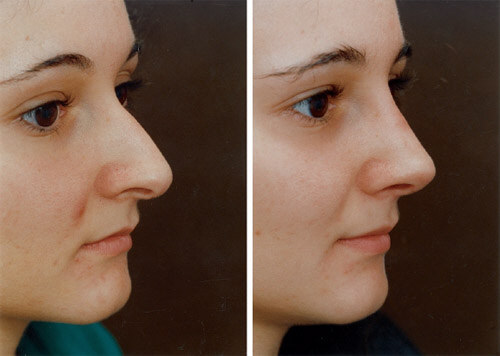
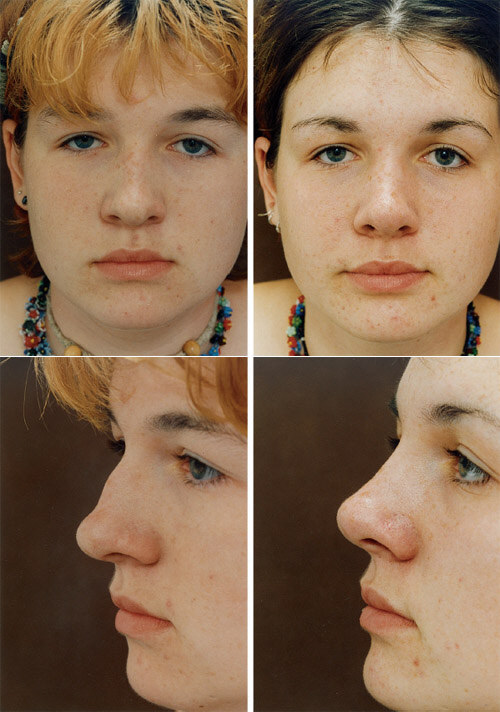
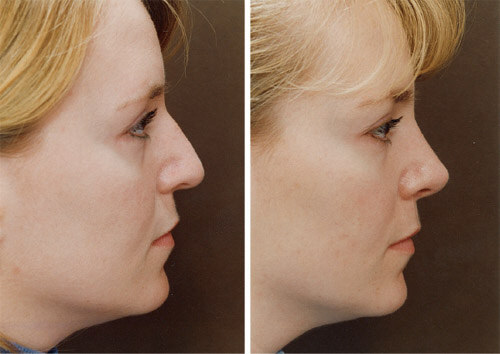
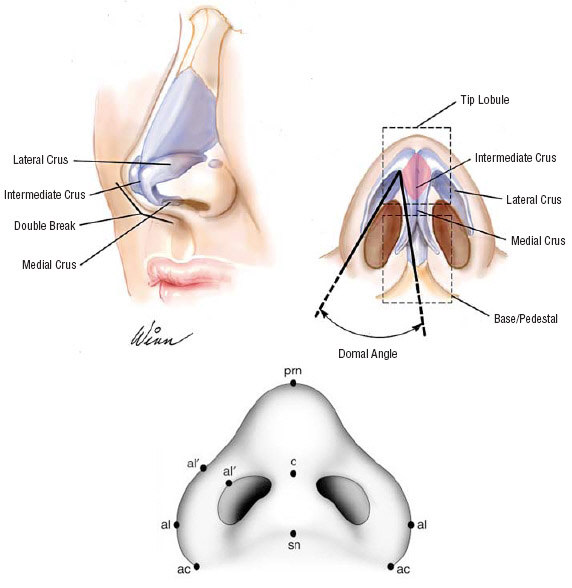
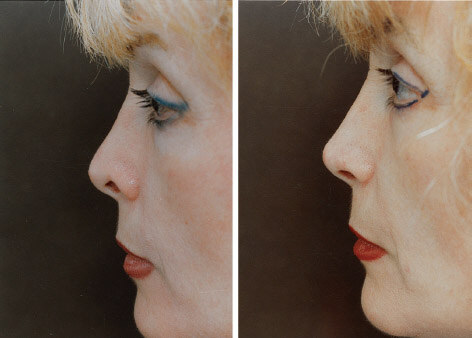
Comments
I've noticed that, like in these photos, a many women get plastic surgeries to alleviate hook-like structural differences on their noses. What's the typical attractive value for that trait, considering how oommon it is among middle eastern populations?
I suspect that the attractiveness value is positive to neutral in middle eastern populations, and neutral to negative in non-middle eastern populations.
Plastic surgeons define "deformity" as "anything we say it is to get people to pay to change it".
None of the women here had a "deformed" nose by any objective standard, with the possible exception of the woman with the narrow middle vault only if she had trouble breathing easily. A real deformity is something that interferes with the nose's ability to perform its natural function, such as a very narrow middle vault or deviated septum that makes breathing difficult, or a hole in the nose such as can be caused by habitual cocaine use.
Great beauties who suffer from these nose "deformities":
Low radix/low dorsum: Vanessa Williams
Narrow middle vault: Michelle Pfeiffer
Inadequate nose tip projection: Sophia Loren
Cephalic malposition of the alar cartilage lateral crura: Uma Thurman
Cephalic malposition of the alar cartilage lateral crura: Vanessa Williams
Cephalic malposition of the alar cartilage lateral crura: Marlene Dietrich
Cephalic malposition of the alar cartilage lateral crura: Grace Kelly
Some of the greatest beauties ever photographed suffer from nose "deformities" because plastic surgeons' definitions of nose "deformities" is ARBITRARY NONSENSE.
:kiss:
GET HEAD SHOTS 8 BY 12 AND HAVE AN ARTIST HAND DRAW /AMMEND YOUR NOSE .
CONSIDER PHOTO SHOT TO CHANGE YOUR NOSE..
MOST DOCTORS ARE LAZZY AND WILL TGRY TO CONVINCE YOU THAT MINIMUM IMPROVEMENT IS WHAT IS NEEDED ..
A GOOD **CANDIDATE IS THERE CODE WORD FOR A SUCKER TO PAY HIGH AND GET VERY LITTLE WORK DONE.
I HAND FIFTHY DOCTORS TELL ME THERE LIES ..NOSE COLAPSE ..THICK SPIN ..I WAS ASKING FOR TOO MUCH..
WATCH OUT THE LATEST STYLE AMONG THESE CUTTERS IS THE STRIGHT RAZOR NOSE JOB LOOK.
EAZY TO FOR THEM AND GOOD PAY .. THEY ARE ALL DOING THE SAME LOOK ...
YOUR FACE AND NOSE SAY EVERY THING ABOUT YOU .IT MUST BE PERFECT..
NOW I HAVE MY READING GLASSES ON;
SOME TIME IN THE FUTURE I AM GOING TO COLLECT PICTURES OF THE MOST BEAUTIFUL NOSES ON MEN AND WOMEN .FULL FACE PORTRATES/ HEAD SHOTS, TO FILL THE COMPUTER SCREEN ...NONE OF THIS THUMB NAIL SIZE.
I WANT TO HAVE A WEB SITE .I THINK THIS WILL BE CALLED NOSE BEAUTIFUL.
I WANT TO PRESENT FACE PROFILES OF NOSES .I MAY HAVE TO DO THIS IN BLACK AND WHITE BECAUSE OF DOWN LOAD TIME ..FULL FACE LARGE SCREEN TO SHOW GOOD NOSES ..
I WILL DEPICT MODEL FACES VS WHAT THESE SERGENS CALL IMPRFOVEMENTS.
IF YOU LOOKED AT 200 PICTURES OF BEFOR AND AFTER NOSE JOBS I SAY 99% OF THE PEOPLE STILL NEED A NOSE JOB .
SUCH IMMESURABLE,MINISCULE CHANGES,WHATS THE POINT